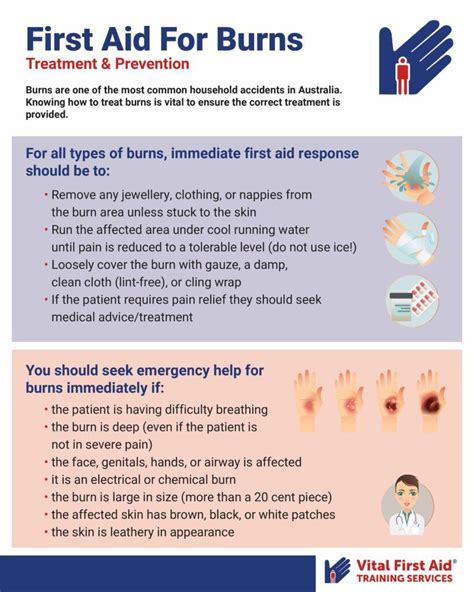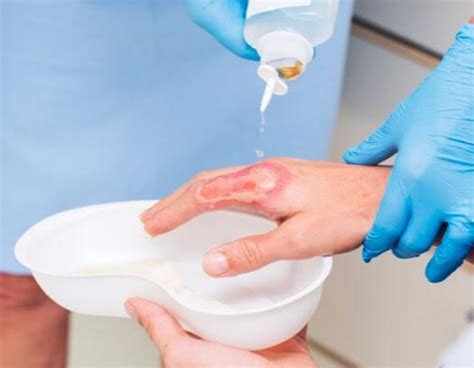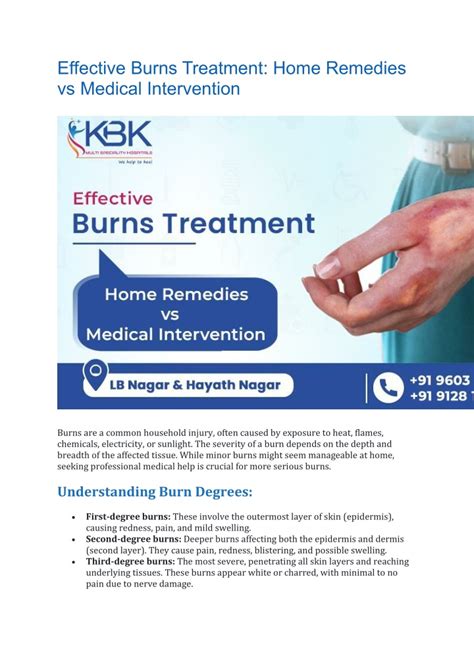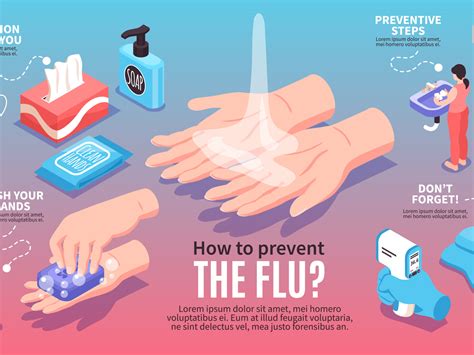Intro
Learn 5 burn treatment tips for minor to severe burns, including wound care, pain relief, and scar prevention, to promote healing and minimize damage from thermal, chemical, or electrical burns.
Burns are a common household injury that can range from mild to severe. They can occur due to various reasons such as exposure to fire, hot surfaces, electrical accidents, or chemical spills. It is essential to know how to treat burns properly to promote healing, prevent infection, and minimize scarring. In this article, we will discuss five burn treatment tips that can help you provide adequate care for burn injuries.
Burns can be classified into three main categories: first-degree, second-degree, and third-degree. First-degree burns affect only the outer layer of the skin, causing redness, swelling, and pain. Second-degree burns extend to the middle layer of the skin, leading to blisters, redness, and swelling. Third-degree burns are the most severe, extending to the deepest layer of the skin, and can cause numbness, white or blackened skin, and limited mobility. Understanding the severity of the burn is crucial in providing the right treatment.
Proper burn treatment is critical in preventing infection, promoting healing, and reducing the risk of long-term damage. Inadequate treatment can lead to serious complications, including infection, scarring, and contractures. Moreover, burn injuries can be painful and emotionally distressing, making it essential to provide compassionate and effective care. By following the right treatment tips, you can help alleviate the suffering of burn victims and promote a speedy recovery.
Burn Treatment Basics

Cooling the Burn
Cooling the burn is an essential step in the treatment process. It helps to reduce the temperature of the skin, ease pain, and prevent further tissue damage. Cool or lukewarm water should be used to cool the burn, as ice or ice water can cause further damage. The burn should be cooled for at least 10-15 minutes, or until the pain subsides. It is essential to monitor the burn victim's body temperature during this process, as cooling the burn can cause hypothermia.Wound Cleaning and Dressing

Pain Management
Pain management is an essential aspect of burn treatment. Burns can be extremely painful, and adequate pain management can help alleviate the suffering of burn victims. Over-the-counter pain medications such as acetaminophen or ibuprofen can be used to manage pain. However, it is essential to follow the recommended dosage and consult a doctor before administering any medication. In severe cases, prescription pain medication may be necessary to manage pain effectively.Advanced Burn Treatment

Skin Grafting
Skin grafting is a surgical procedure that involves transplanting healthy skin from one part of the body to another. This procedure is often used to treat severe burns that have damaged a large area of skin. Skin grafting can help promote healing, reduce scarring, and improve the appearance of the affected area. However, skin grafting is a complex procedure that requires specialized training and equipment, and should only be performed by a qualified medical professional.Preventing Infection

Recognizing Signs of Infection
Recognizing signs of infection is crucial in preventing serious complications. Signs of infection include redness, swelling, increased pain, pus, or a foul odor. If any of these signs are present, it is essential to seek medical attention immediately. Infections can be treated with antibiotics, and in severe cases, may require hospitalization.Promoting Healing

Nutrition and Burn Healing
Nutrition plays a critical role in burn healing. A healthy diet that is rich in protein, vitamins, and minerals can help promote healing, reduce the risk of infection, and improve overall health. Burn victims should be encouraged to eat foods that are high in protein, such as lean meats, fish, and eggs. Additionally, foods that are rich in vitamins and minerals, such as fruits, vegetables, and whole grains, can help promote healing and improve overall health.Long-Term Care

Reconstructive Surgery
Reconstructive surgery is a surgical procedure that is used to improve the appearance of the affected area. This procedure can help reduce scarring, improve mobility, and enhance the overall appearance of the affected area. Reconstructive surgery is often used to treat severe burns that have caused significant damage to the skin and underlying tissue. However, reconstructive surgery is a complex procedure that requires specialized training and equipment, and should only be performed by a qualified medical professional.What are the different types of burns?
+Burns can be classified into three main categories: first-degree, second-degree, and third-degree. First-degree burns affect only the outer layer of the skin, causing redness, swelling, and pain. Second-degree burns extend to the middle layer of the skin, leading to blisters, redness, and swelling. Third-degree burns are the most severe, extending to the deepest layer of the skin, and can cause numbness, white or blackened skin, and limited mobility.
How do I treat a minor burn?
+To treat a minor burn, stop the burning process, cool the burn with cool or lukewarm water, clean and dress the wound, and provide pain management. It is essential to monitor the burn victim's body temperature during the cooling process, as cooling the burn can cause hypothermia.
When should I seek medical attention for a burn?
+It is essential to seek medical attention immediately if the burn is severe, covers a large area of the body, or if the burn victim is experiencing signs of infection, such as redness, swelling, increased pain, or pus. Additionally, if the burn victim is experiencing difficulty breathing, or if the burn is on the face, hands, or feet, medical attention should be sought immediately.
In conclusion, burn treatment requires a comprehensive approach that involves stopping the burning process, cooling the burn, cleaning and dressing the wound, and providing pain management. By following these burn treatment tips, you can help alleviate the suffering of burn victims and promote a speedy recovery. Remember to seek medical attention immediately if the burn is severe or if the burn victim is experiencing signs of infection. With proper care and attention, burn victims can recover fully and regain their normal functioning. We invite you to share your thoughts and experiences on burn treatment in the comments section below.
